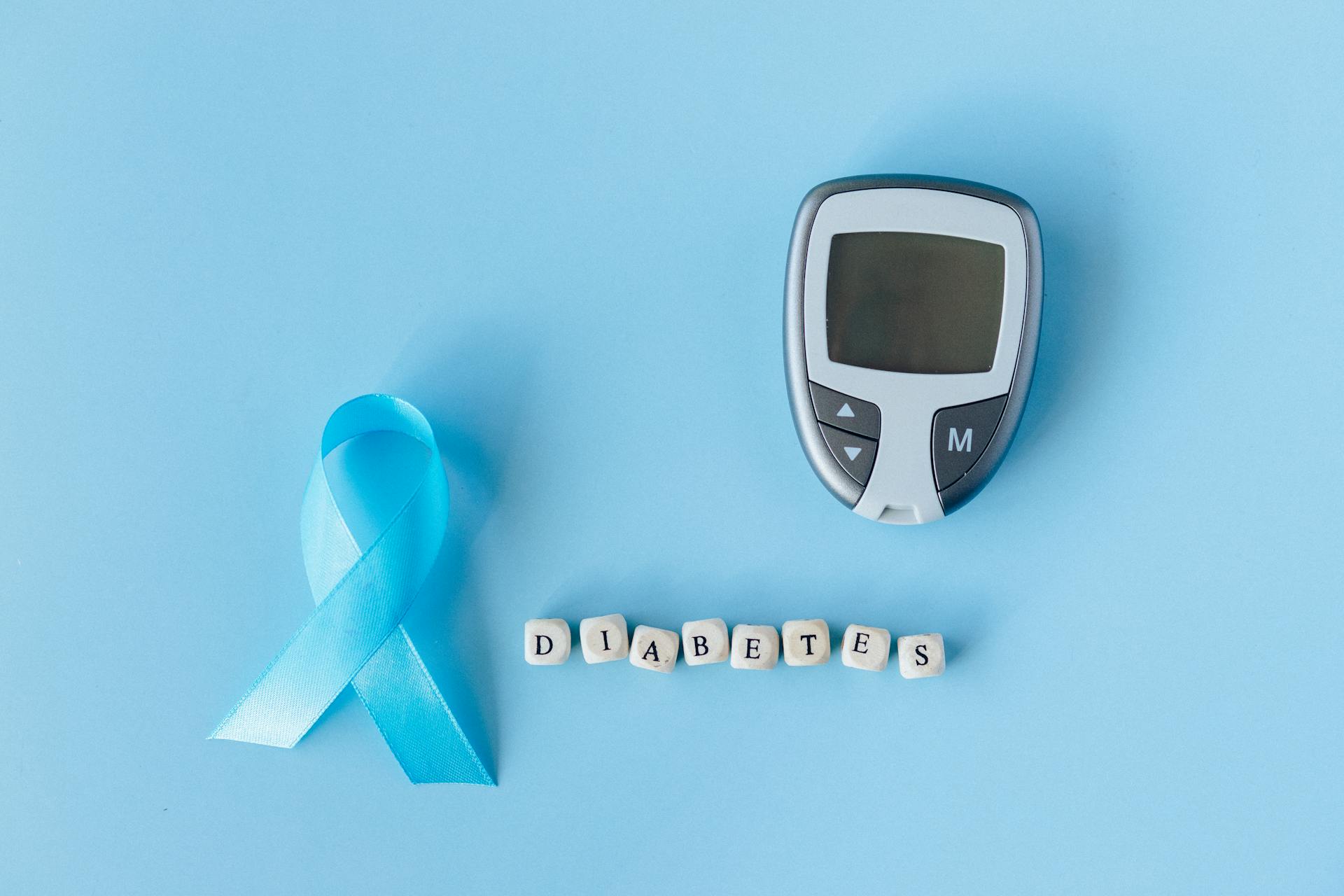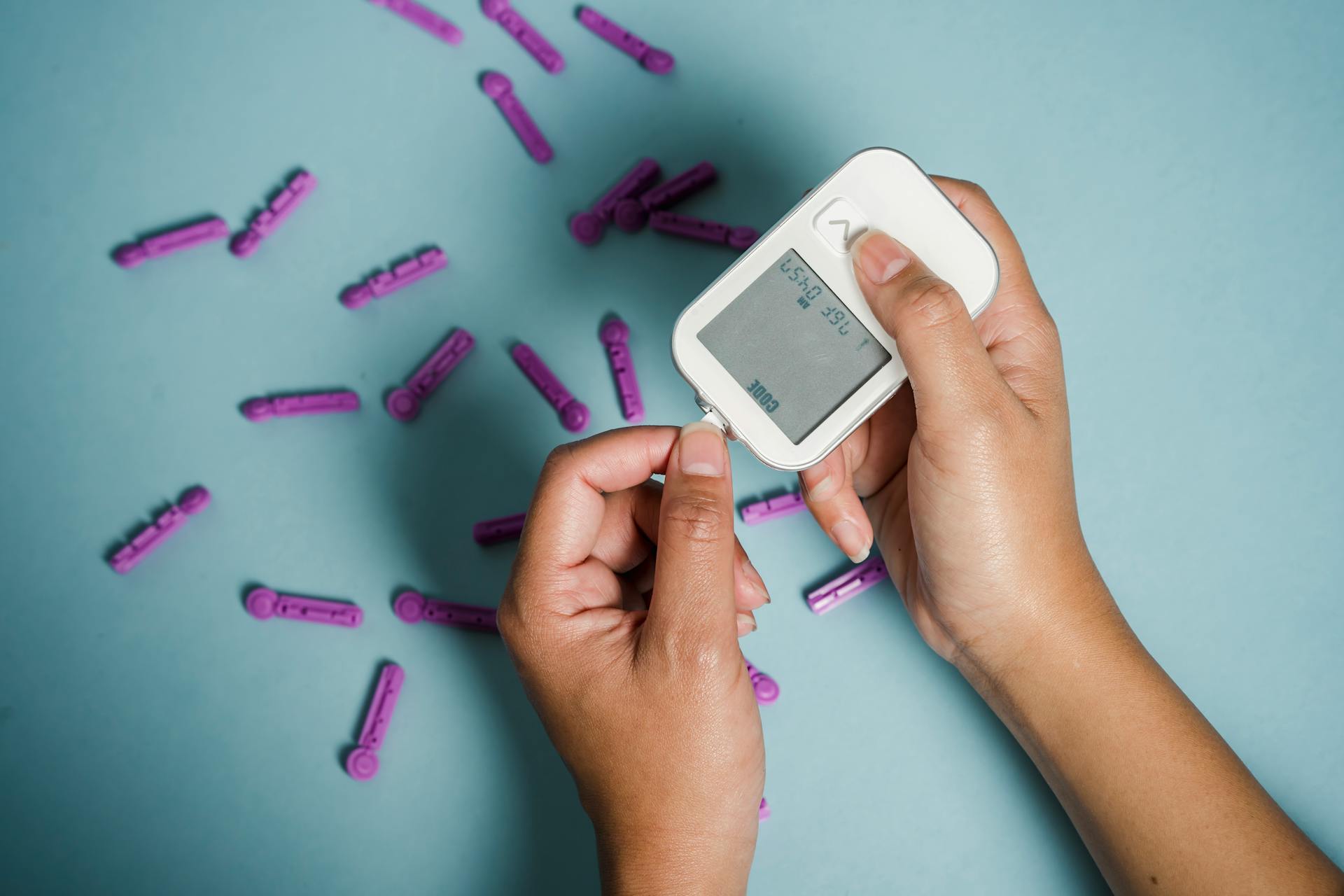
Diabetes service dogs are trained to assist individuals with diabetes in managing their condition. They can detect changes in blood sugar levels and alert their owners.
These dogs are trained to perform specific tasks, such as detecting low blood sugar, reminding owners to take medication, and even fetching help in emergency situations.
Their keen sense of smell allows them to detect subtle changes in their owner's body chemistry.
A unique perspective: Canine Diabetes Glucose Levels
What Are Diabetes Service Dogs?
Diabetes service dogs are specially trained to detect high and low blood sugars in individuals with diabetes.
They can detect high and low blood sugars before they reach dangerous levels, which can be especially helpful in preventing seizures.
These dogs can detect the chemical changes in their owner's body when their blood sugars are rapidly rising or falling.
Under the Americans with Disabilities Act, when diabetes service dogs are fully trained and certified, they can accompany their owners almost everywhere they go.
For another approach, see: Can Service Dogs Detect Seizures
Benefits and Effectiveness
Diabetes service dogs are incredibly effective at helping their owners manage their condition. They have a 95% success rate of detecting changes in their owner's blood sugar levels.
A dog's sense of smell is up to 100,000 times more sensitive than a human's, making them perfect for this type of work. With over 225 million scent receptors in their noses, they can pick up on subtle changes in their owner's body odor.
These dogs are trained to alert their owners to low or high blood sugar levels, and they can even be trained to retrieve a phone or a diabetes supply bag. Some dogs are even trained to dial 911 on a special device to get help in an emergency.
Having a diabetes service dog can have a huge impact on a person's quality of life. They can help alleviate stress, anxiety, and depression, which are common issues for people living with chronic illnesses like diabetes.
Suggestion: How to Help Dogs with Skin Allergies
Here are some ways that diabetes service dogs can help their owners:
- Tapping the owner repeatedly with their nose
- Pawing at the owner’s lap
- Jumping up into the owner’s lap
- Barking or whining
- Alerting other family members by running to them to bring help
- Bringing over needed objects, such as a diabetes supply bag
- Retrieving a phone for the owner
- Some dogs may even be trained to dial 911 on a special device to get help
With a diabetes service dog by their side, people with diabetes can feel more in control of their condition and more independent. These dogs are truly a lifesaver for many people, and their effectiveness is undeniable.
You might enjoy: Hearing Dogs for Deaf People
Dog Ownership Eligibility
To qualify for a diabetes alert dog, you'll typically need to have a diagnosis of diabetes and experience hypo-unawareness, which affects nearly 40% of people with type 1 diabetes.
Diabetes alert dogs are especially helpful for people who are sensitive to insulin or prone to extremely low blood sugars.
Individuals who have frequent low blood sugars, suffer from low-blood-sugar-induced seizures, or experience frequent low blood sugars at night may also benefit from a diabetes alert dog.
Additionally, individuals with co-morbidities or multiple diagnoses may find a diabetes alert dog to be a valuable asset.
A continuous glucose monitor (CGM) with alerts and alarms is often recommended by endocrinologists before considering a diabetes alert dog.
A fresh viewpoint: How Do Service Dogs Know When to Alert
Some private agencies may have their own eligibility criteria, so it's essential to check with them before applying.
Typically, a diagnosis of diabetes and hypo-unawareness will be enough to qualify for a diabetes alert dog.
Here are some common reasons why people qualify for a diabetes alert dog:
- Frequent low blood sugars
- Low-blood-sugar-induced seizures
- Frequent low blood sugars at night
- Living alone with diabetes
- Co-morbidities or multiple diagnoses
Service Dog Certification and Training
You can get a diabetes alert dog through a service dog agency, which can be found online or through recommendations from your doctor, local diabetes non-profit, or support group.
Almost all service dog agencies have an online presence, and doing research can help you get a sense of their teaching methods and process for pairing alert dogs with applicants.
You don't need to show proof that the dog has been certified as a service animal to access public spaces, but it's legal to require you to show that you need a service animal, such as to board a plane.
For more insights, see: Medical Alert Dog Training
Training involves handling and working with a diabetic-alert dog effectively, as well as learning to interpret the signals and alerts the dog provides to indicate changes in your blood sugar level.
The organization will match you with a suitable diabetic alert dog based on your specific needs and lifestyle after you've completed the training.
A unique perspective: Cardiac Alert Dog Training
Restrictions and Resources
Owning a diabetes service dog can be a significant financial commitment. The initial purchase or adoption fees, training, veterinary care, food, and supplies can add up quickly.
You'll need to assess your financial resources to ensure you can afford the long-term costs of owning a diabetic-alert dog. Some organizations or foundations offer financial aid or assistance programs for those in need.
It's essential to consider the ongoing maintenance costs, including regular veterinary check-ups and potential health issues that may arise.
Discover more: Do Service Dogs Need to Be Registered
Places Where Service Dogs Are Restricted
Restaurant kitchens are off-limits to service animals due to health and safety concerns. This includes any areas where food is prepared or handled.
Construction sites can also pose a danger to service animals, making them restricted areas. This is due to the presence of hazardous materials and equipment.
Ultra-clean pharmaceutical production facilities are another exception, as they require a sterile environment that service animals may compromise. This is a specific example of a place that may pose a health hazard to the dog or others.
If you're planning to take your service dog to a new location, it's essential to check if there are any restrictions in place.
Financial Resources
Having a diabetic-alert dog can be a life-changing experience, but it's essential to consider the financial resources required to care for them. Expenses may include the initial purchase or adoption fees, training, veterinary care, food, supplies, and ongoing maintenance costs.
The cost of obtaining and caring for a diabetic-alert dog can be substantial, so it's crucial to assess your financial situation and ensure you can afford the long-term commitment.
Some organizations and foundations offer financial aid or assistance programs for those in need, which can help make owning a diabetic-alert dog more accessible.
It's also worth noting that not all service dog agencies are created equal, with for-profit and nonprofit agencies varying significantly in cost.
You might enjoy: Cockapoo Care
Find a Reputable Organization
Finding a reputable organization to help you get a diabetes alert dog can be a daunting task, but don't worry, I've got you covered. You can start by doing a bit of online research to get a sense of their teaching methods and process for pairing alert dogs with applicants.
There are both for-profit and nonprofit agencies, and the cost will largely depend on which type you choose. You can also contact Assistance Dogs International for information about agencies that breed service dogs in your state.
Your endocrinologist, local diabetes non-profit, or even a local diabetes support group may also have recommendations for potential diabetes alert dog agencies near you. This can be a great way to get personalized advice and find an agency that's a good fit for you.
To ensure you're working with a reputable organization, consider factors such as their success rate, certification, reviews, and overall reputation. You can also look into organizations like All Stage Canine Development, which specializes in training diabetic alert services and providing these service animals.
Here are some resources to help you get started:
- AKC Good Dog HelpLine
- Puppy Seekers
- Groomer Seekers
- Register Your Dog
Diagnosis and Support
To qualify for a diabetes service dog, you'll need a proper medical diagnosis of diabetes, which can include Type 1, Type 2, or even gestational diabetes.
Your healthcare provider will need to document your medical condition with records from their office, so be sure to keep all your medical records up to date.
A doctor's recommendation is also essential, as it confirms that you would benefit from the assistance of a service animal due to the nature and severity of your diabetes.
Recommended read: Medical Response Dog
Ongoing Support
Ongoing support is crucial for diabetic alert dog owners. This means you can expect regular check-ins and training sessions to ensure you and your dog are working together effectively.
You'll have access to professional advice and resources to help you navigate any challenges that come up. This could be anything from specific situations to general guidance on caring for your dog.
Maintaining regular contact with the organization that provided your diabetic alert dog is essential. This will help you stay on track and continue to build a strong bond with your dog.
Ongoing support may also include assistance in specific situations, such as helping you understand how to respond to your dog's alerts or providing guidance on how to handle medical emergencies.
Here's an interesting read: Diabetic Service Dog Cost
Receiving a Life-Changing Diagnosis
Receiving a life-changing diagnosis can be a challenging experience. For Lelia, it started with symptoms that had her family thinking she had the flu, but her mother's nursing instincts kicked in and she knew something was off.
Weight loss, thirst, and excessive urination are all warning signs that can lead to a diagnosis of diabetes. In Lelia's case, her blood sugar levels were a crazy-high 688, far above the normal range of below 140 mg/dL.
A diagnosis of Type 1 diabetes means that the pancreas makes little to no insulin, a hormone crucial for glucose transport into cells for energy. This requires a significant adjustment in lifestyle and care.
A life-changing diagnosis can be overwhelming, but it's essential to have a supportive team. The Barbara Davis Center for Diabetes at the University of Colorado Anschutz Medical Campus is one such resource, where families can spend hours learning about the disease and its care.
Receiving a diagnosis can be a long process, but with the right support, it's possible to thrive. As Lelia said, it's comforting to know that there are people who will be there to help you every step of the way.
Explore further: Shiba Inu Life Stages
Frequently Asked Questions
Does diabetes qualify for a service dog?
To qualify for a service dog, you must have Type 1 diabetes complicated by hypoglycemic unawareness and be at least 18 years old. If you meet these criteria, you may be eligible for a diabetes assist dog that can help manage your condition.
How much does a diabetes service dog cost?
A diabetic alert dog typically costs between $8,000 to $20,000, although some non-profits offer free dogs with training costs. Learn more about organizations that provide financial assistance for diabetes service dogs.
Do diabetic alert dogs really work?
While there's limited evidence that diabetic alert dogs can accurately detect blood sugar changes, research suggests they may still have a positive impact on people with diabetes, possibly due to increased engagement with their condition.
What is the best dog breed for a diabetic alert dog?
The most successful breeds for diabetic alert dogs are Golden Retrievers, Poodles, Labrador Retrievers, and Collies, which excel in service work due to their intelligence and trainability. Discover why these breeds are well-suited for this important role.
Who qualifies for a diabetic alert dog?
Individuals with Type 1 diabetes complicated by hypoglycemic unawareness may qualify for a diabetic alert dog. Proof of diagnosis is required to apply.
Sources
- https://ourdogssavelives.org/programs/d4d/
- https://diabetesstrong.com/how-to-get-a-diabetes-alert-dog/
- https://www.allstagecaninedevelopment.com/how-do-you-qualify-for-diabetic-alert-dog/
- https://news.cuanschutz.edu/news-stories/diabetic-alert-dog-brings-comfort-and-sleep-to-little-girls-family
- https://eenp.org/programs/medical-alert
Featured Images: pexels.com


